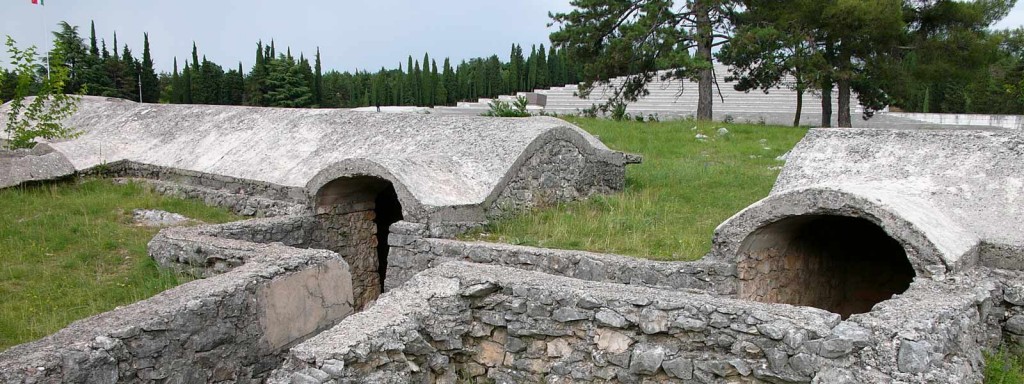



Redipuglia military memorial was built in 1938 based on a project by the architect Giovanni Greppi and the sculptor Giannino Castiglioni.
The work, built on the slopes of Mount Sei Busi, bitterly disputed peak in the first phase of the Great War (first, second and fourth battle of the Isonzo), looks like a military array with the tomb of Emanuele Filiberto di Savoia at the base. Aosta, commander of the 3rd Army, to which those of his generals are attached.

Symbolically encloses the entrance to the shrine, at the foot of the monumental staircase, a large anchor chain that belonged to the torpedo boat Grado, formerly belonging to the Austro-Hungarian navy (k.u.k. Kriegsmarine) with the name of Triglav and sold to Italy after the end Of the war. Immediately beyond, a large square, paved in Karst stone, stretches on a slight slope, crossed on its median line by the Via Eroica, which runs between two rows of bronze plates, nineteen on each side, each of which bears the name of a place where the fight was most bitter and bloody. At the end of the Via Eroica rises the solemn stairway which houses, in alphabetical order from bottom to top, the remains of 40,000 known dead, whose names appear engraved in individual bronze tombstones.

The majestic staircase - formed by twenty-two steps on which the graves of the fallen are lined up, on the front and at the base of which rises, isolated, that of the Duke of Aosta, commander of the 3rd army, flanked by the urns of his generals who died in combat - it is similar to the powerful and perfect array of a whole great unit of a hundred thousand soldiers. The Duke of Aosta, who died in 1931, had asked to have the honor of being able to be deposed here among the thousands of soldiers who lost their lives on the battlefield.

The tomb is made from a porphyry monolith weighing 75 tons. The bodies of the 39,857 identified fallen soldiers follow, arranged on the twenty-two steps. The inscriptions all bear the word "Present", which refers to the rite of appeal of the squad where the team leader shouted the name of the deceased comrade and the kneeling crowd responded with the cry "Present". In the last step, in two large common tombs on the sides of the votive chapel, lie the bodies of 60,330 unknown fallen.

Personal objects of Italian and Austro-Hungarian soldiers are kept in the chapel and in the two adjacent rooms. Today the chapel is enriched by a statue representing an Assumption; she is the Queen of Peace. An Assumption that wants to recall the need to give the shrine the role of connecting the people of Europe in order to promote a reflection on the ethical lacerations that wars produce.
In the chapel there is also exhibited the head of a suffering Christ recovered in 1995 in the dolina dei 500 or dolina della Morte on Mount Sei Busi, one of the most important relics found in the area that adorned a cross overlooking a large common grave.
On 3 September 2014 the chapel was transformed into a church, with a solemn rite. The church is now dedicated to Mary Most Holy Queen of Peace, as a symbol of all mothers with their children in war. On 3 May 2017 the Regina Pacis church took on as co-patrons, in addition to St. Francis and St. Catherine of Siena, John Paul II, Benedict of Norcia, Cyril and Methodius. On the same day, the Guard of Honor for the Regina Pacis was set up.

The large mausoleum was built in front of the first war cemetery of the 3rd Army on the Sant'Elia hill, which today is a sort of open-air museum known as the park of Remembrance. Along the avenue, adorned with tall cypresses, there are stones in karst stone with reproductions of the relics and epigraphs that adorned the tombs of the first shrine.
On the top of the hill a fragment of a Roman column, coming from the excavations of Aquileia, celebrates the memory of the fallen of all wars, "without distinction of times and fortunes". The facility, the most monumental ossuary of the Fascist era, embodies "the apotheosis of equality, anonymity and military discipline beyond death, a triumph - set in stone - of the collective demand over individual identity".

In conjunction with the construction of the shrine, the Redipuglia station was also built, to be framed with a view to monumentalizing the area.
Tomb of Margherita Kaiser Parodi, the only woman buried in the shrine.

The only woman buried in the shrine is a Red Cross nurse, who died at 21, named Margherita Kaiser Parodi. Her tomb is located in the first row and stands out because a large cross is carved in the facade.
Redipuglia Military Memorial
Address: Via III° Armata, 17
Phone: 0481 489024
Site:
http://itinerarigrandeguerra.itLocation inserted by
Stefano Vigolo